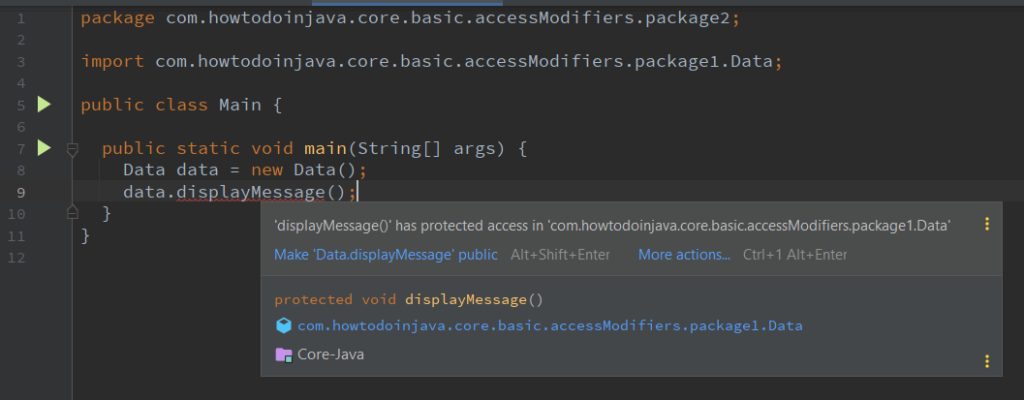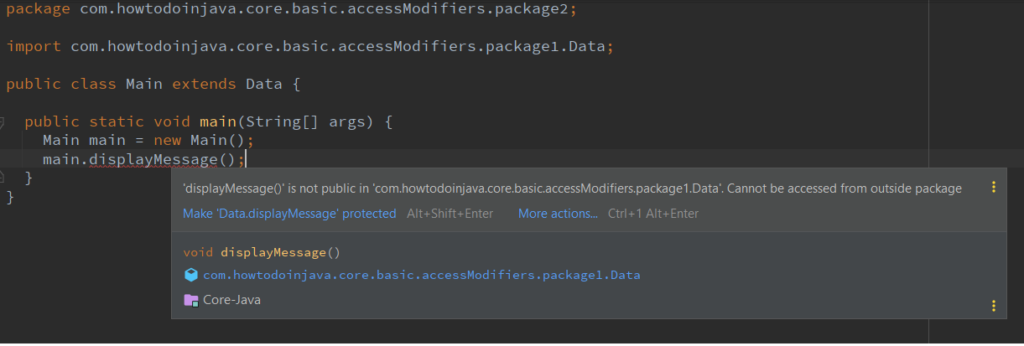Java provides four access modifiers to set access levels for classes, variables, methods and constructors i.e. public, private, protected and default. These access level modifiers determine whether other classes can use a particular field or invoke a particular method.
1. Access Modifiers
Let’s quickly compare these access modifiers in nutshell.
- public – accessible everywhere
- protected – accessible in the same package and subclasses outside the package
- default – accessible only in the same package
- private – accessible only in the same class
The access specifiers can be ordered based on their strictness as below. The public is the least restrictive, and the private is the most restrictive.
public > protected > package-private (or default) > private
1.1. public
The public members are accessible from everywhere. A public class, method, constructor, or interface could be accessed from any other class in the application. However, if the public class we are trying to access is in a different package, then we must import the class before using it.
public class Data {
private String format;
public String getFormat() {
return this.format;
}
public void setFormat(String format) {
this.format = format;
}
}In the above example, getFormat() and setFormat() methods are public so they can be accessed from any class.
Please note that the fields in an interface are implicitly public static final and the methods in an interface are, by default, public.
1.2. protected
The protected members are accessible by the classes of the same package and the subclasses outside the package.
public class Data {
protected void displayMessage(){
System.out.println("Test message");
}
}In Data class, the method displayMessage() is declared protected, so it can be accessed by all the classes present in the same package where HelloWorld.java is present, as well as child classes present in other packages as well.
public class Main {
public static void main(String[] args) {
Data data = new Data();
data.displayMessage();
}
}If we try to access the displayMessage() in another package without extending the Data class, we get the following compilation error:
'displayMessage()' has protected access in 'com.howtodoinjava.core.basic.accessModifiers.package1.Data'
When we inherit the Data class, then we can access the displayMessage() outside the current package.
public class Main extends Data {
public static void main(String[] args) {
Main main = new Main();
main.displayMessage();
}
}1.3. default
The default access modifier means we do not explicitly declare an access modifier for a class, field, method, etc. The default members are accessible only by the classes in the same package.
Let us remove the protected access from the displayMessage() in the Data class. It changes the access to default.
public class Data {
void displayMessage(){
System.out.println("Default Test message");
}
}Now when we try to access the displayMessage() in the child class outside the package, we will start getting the compilation error:
'displayMessage()' is not public in 'com.howtodoinjava.core.basic.accessModifiers.package1.Data'. Cannot be accessed from outside package
1.4. private
The private access modifier is the most restrictive access level. The topmost classes and interfaces cannot be private. The private members are accessible within the same class only. The private methods, variables, and constructors can only be accessed within the declared class itself.
We are modifying the previous example again by changing the default access to private access for the displayMessage() method.
public class Data {
private void displayMessage(){
System.out.println("Default Test message");
}
}Now the method is private so no other class can access it directly.
2. Levels of Access Control
There are two levels of access control.
- Class level access – allows modifiers to be public, or package-private (default).
- Method level access – allows modifiers to be public, private, protected, or package-private (default).
Local variables and formal parameters cannot take access specifiers. Since they are inherently inaccessible to the outside according to scoping rules, they are effectively private.
Both private and protected can be (and frequently are) applied to nested classes and interfaces, just never top-level classes and interfaces.
3. Conclusion
Access levels affect us in two ways.
- First, when you use classes that come from another source, access levels determine which members of those classes your own classes can use.
- Second, when you write a class, you must decide what access level every member variable and every method in your class should have.
If other programmers use your class, you want to ensure that errors from misuse cannot happen. Access levels can help you do this.
Happy Learning !!


Comments